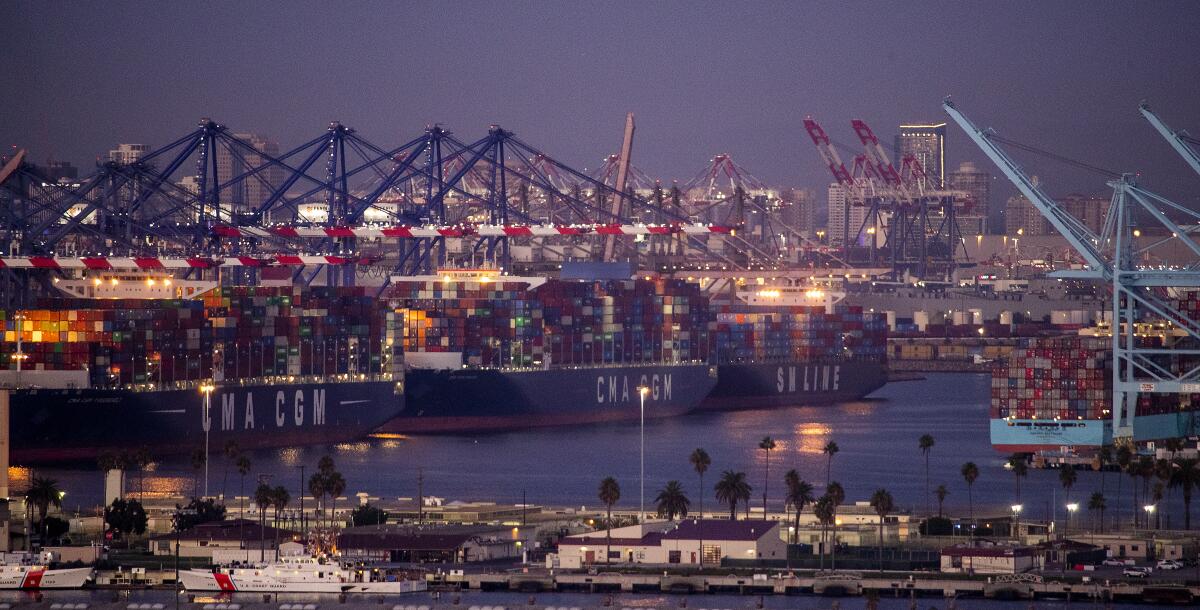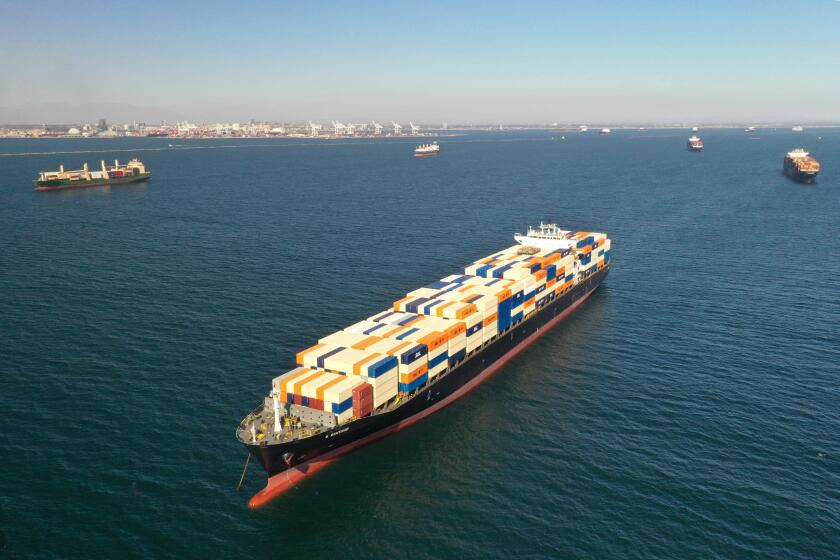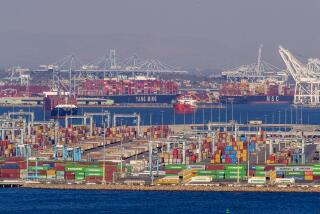News Analysis: Ahead of holidays, Biden tries to untangle supply chain mess

President Biden could face political blowback from unhappy shoppers as he struggles to fix supply chain problems.
- Share via
WASHINGTON — President Biden wants to save Christmas — but he may not be able to.
He announced Wednesday that the Port of Los Angeles would operate around the clock to alleviate a logistical bottleneck that has left dozens of container ships idling off the California coast and Americans waiting longer to get products manufactured overseas.
Longshoremen will work through the night and major retailers and shipping companies have pledged to clear cargo off the docks faster than before, changes that are intended to speed the flow of toys, electronics and other gifts to American doorsteps during the holiday season.
“Today’s announcement has the potential to be a game changer,” Biden said as he acknowledged that people are worrying about whether everything from “toasters to sneakers to bicycles to bedroom furniture” was going to be available.
A global supply chain breakdown has resulted in gridlock at the ports of Los Angeles and Long Beach and beyond.
However, the plan addresses only one link in a global supply chain largely outside of Biden’s control, meaning he faces potential blame from unhappy shoppers while also lacking the power to fix the mess.
Biden can’t force overseas factories to keep churning out products. He can’t hire more truck drivers to pick up cargo when it arrives. And he can’t stop the pandemic that continues to disrupt operations all over the world.
The bottom line: Americans want their stuff, and there’s very little that Biden can do to get it to them.
Matthew Sherwood, global economist at the London-based Economist Intelligence Unit, described the White House’s actions as “fairly limited.”
Many items destined for retailer shelves this holiday season are hopelessly snarled in the global supply chain. What does that mean for shoppers?
“I think the administration is doing what it can, but the reality is there’s not that much it can do beyond what they’re announcing,” he said.

Nick Vyas, executive director of the Randall R. Kendrick Global Supply Chain Institute at USC, commended Biden’s effort to bring various groups together and said more private sector companies would need to heed his call to step up operations if they want to address the problem.
“If all of these were to click, I think we’ll see some results in the next two to three months,” he said.
Whether the supply chain problems are Biden’s fault may not matter to voters, who tend to direct their displeasure toward the person in charge.
Biden faces a similar challenge with the coronavirus. His administration has made enough vaccines available for every American, but millions are still unwilling to get their shots, prolonging the deadly COVID-19 pandemic — and driving down the president’s poll numbers.
White House Press Secretary Jen Psaki said recently that souring public opinion is “a reflection of people being sick and tired of COVID,” but that the president understands “the buck stops with him.”
When it comes to the worldwide flow of goods, Psaki demurred on Wednesday when asked whether the administration could ensure that holiday packages would arrive on time.
“We are not the Postal Service, UPS or Fedex,” she said. “We cannot guarantee.”
Extreme heat is endangering California warehouse workers, who often labor without air conditioning.
Psaki was also cautious about promising Americans that the situation would improve quickly, especially at a time when analysts suggest that problems could persist into next year.
“I don’t want to make a prediction because it’s not just one issue,” she said.
Jeremy Rosner, a Democratic pollster, described supply chain problems as more of an annoyance than a crisis at this point, suggesting any political fallout would be limited.
“It’s not shortages of things that are making it impossible for people to put food on the table or drive to work,” he said.
However, Rosner acknowledged that a difficult holiday season could add to “a frustrating autumn of discontent,” including controversies over the withdrawal from Afghanistan and unhappiness over the lingering pandemic.
The current gridlock reflects a confluence of challenges. Over the years, supply chains have become increasingly vulnerable to disruption as companies have narrowed and accelerated the time for sourcing and transporting goods.
Then the pandemic upended the global economy, plunging the world into a recession and leading to a burst of demand for certain goods.
Jeffrey Sonnenfeld, a Yale University management professor who regularly meets with and surveys top corporate executives, said Biden’s announcement would be welcomed in corner offices. Until recently, he said, major retailers and transportation companies believed they could handle supply chain problems on their own.
“It’s only now that the private sector has conceded defeat. They’re asking for help and getting it. It’s a big breakthrough, symbolic and in substantive ways,” he said.
One of the biggest economic threats is that supply chain bottlenecks and various shortages are sparking higher inflation. The government said Wednesday that inflation rose last month, with consumers paying 5.4% more for goods and services compared with a year ago, the highest rate in more than a decade.
White House economists and policymakers at the Federal Reserve have viewed the recent surge in consumer prices as temporary, but inflation has been running well above the Fed’s comfort level since spring. Persistently higher inflation could cause complications for the Fed’s interest rate policies, and it could influence consumer spending and wage growth. Already, analysts have sharply marked down economic growth for the second half of this year, and 2022 is likely to bring slower growth.
The supply chain snarl has presented Biden with another opportunity to push his infrastructure plans, which are stalled on Capitol Hill as Democrats sort out how much money they want to spend on expanded safety net programs. The legislation, which passed the Senate but is awaiting a vote in the House, includes $17 billion to modernize and expand port facilities.
Biden described the legislation as “the biggest investments in ports in our history.”
“We need to think big and bold,” he said Wednesday.
But even if the measure makes it to the president’s desk for his signature, the full benefits probably will be years away.
“In the longer run, there are infrastructure investments that could expand system capacity, but that’s not a quick fix,” said Phil Levy, chief economist at Flexport, a San Francisco-based freight shipment and customs brokerage company.
More to Read
Get the L.A. Times Politics newsletter
Deeply reported insights into legislation, politics and policy from Sacramento, Washington and beyond. In your inbox three times per week.
You may occasionally receive promotional content from the Los Angeles Times.













